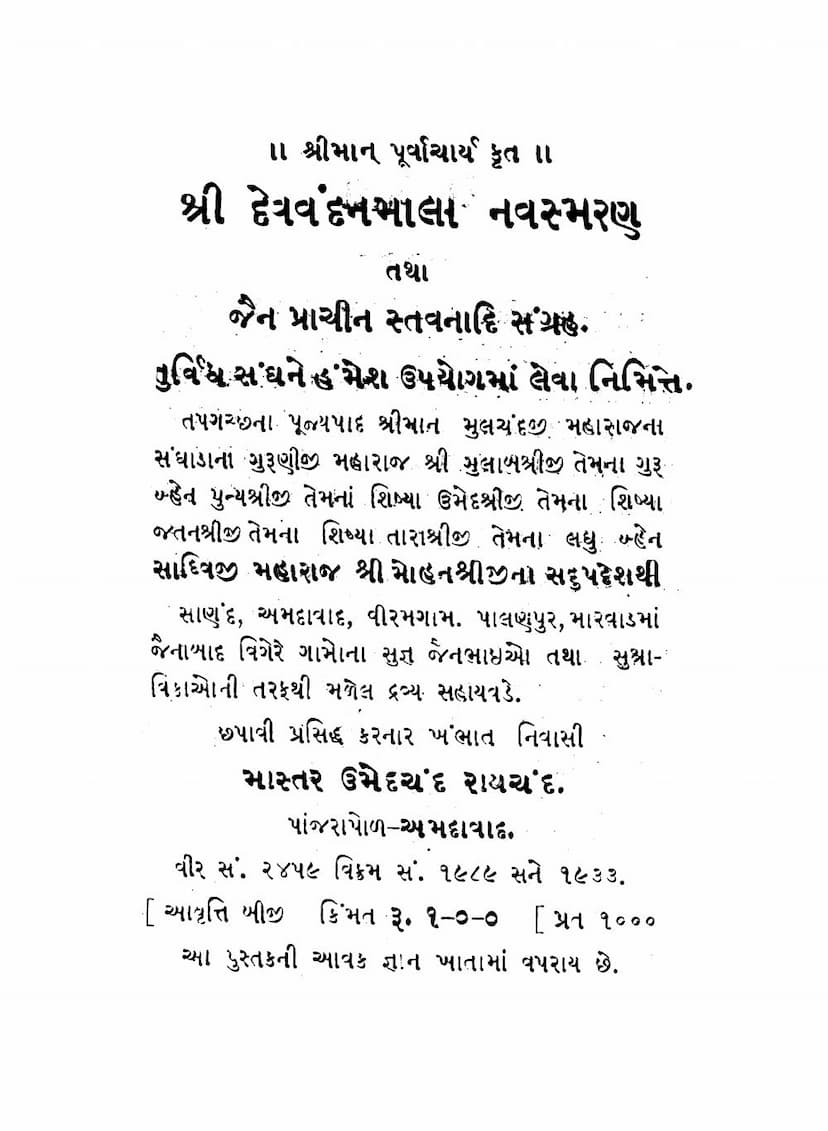Devvandanmala Navsmaran Tatha Prachin Stavanadi
Added to library: September 1, 2025

Summary
This document is the "Devvandanmala Navsmaran Tatha Prachin Stavanadi" by Umedchand Raichand Master. It is a comprehensive collection of Jain prayers, verses, hymns, and devotional songs, intended for the regular use of the Jain community.
Here's a breakdown of its key aspects based on the provided pages:
Core Content:
- Title: Devvandanmala Navsmaran Tatha Prachin Stavanadi (Collection of Devotional Verses, Nine Recollections, and Ancient Hymns)
- Author/Publisher: Umedchand Raichand Master
- Purpose: To be useful for the four-fold Jain community (monks, nuns, laymen, and laywomen) at all times.
- Content Breakdown: The book is a vast compilation of Jain devotional literature. Based on the table of contents and the sampled pages, it includes:
- Navsmaran (Nine Recollections): Essential Jain mantras and prayers.
- Stavans (Hymns/Praise Songs): A wide variety of devotional songs praising Jain Tirthankaras, deities, and significant events. These are often organized by the deity praised (e.g., Parshvanath, Neminath, Adinath, Mahavir) or the occasion (e.g., Diwali, Chaturmas).
- Chaitya Vandan (Temple Worship Verses): Specific verses used during temple rituals and prayers.
- Duhas (Couplets): Short, rhyming verses conveying spiritual messages.
- Sajjhay (Devotional Songs/Narratives): Longer narrative songs recounting stories of saints, celestial beings, and Jain principles.
- Vidhi (Rituals/Procedures): Instructions for specific religious practices like Tapa (asceticism) and the observance of certain religious days.
- Specific Collections: Includes famous compositions like "Ratnakar Pacchishi," "Punyaprakash nu Stavan," "Shatrunjay Laghukalp," and verses dedicated to specific Tirthas like Shatrunjay and Ashtapadji.
- Guru Bhakti: A photo of Acharya Maharaj Shri Kamal Surishwarji is included, highlighting the importance of Guru devotion.
- Auspicious Occasions: Prayers for events like Diwali, Gyan Panchami, Paryushan, and annual rituals like Samvatsari.
Context and Publication:
- Second Edition: The book is a second edition, indicating its popularity and usefulness.
- Publication Year: Published in Vikram Samvat 1989 (1933 CE).
- Compilation: It was compiled with the inspiration and guidance of Pujyapad Shri Gulabshriji Maharaj and her lineage of gurus, and with the financial support from Jain brothers and sisters from various cities like Sanand, Ahmedabad, Viramgam, Palanpur, and Marwad.
- Purpose of Income: The income generated from the sale of this book is dedicated to the "Gyan Khata" (knowledge fund), likely for educational purposes within the Jain community.
- Affordability: Despite its substantial size (46-47 "fermas" or signatures, significantly larger than the first edition), the price was kept very low at one rupee, making it accessible.
- Accuracy: The compiler acknowledges that the text was compiled from various handwritten manuscripts and different published books of Chaitya Vandan, and therefore minor variations in words or phrases might exist. They seek forgiveness for any errors or inadvertent omissions.
- Printing: The book was printed by Shah Manilal Chhaganlal at Shree Vir Vijay Printing Press, Kalupur Tankshal, Ahmedabad.
Overall Significance:
The "Devvandanmala Navsmaran Tatha Prachin Stavanadi" is a significant work for Jainism as it preserves and makes accessible a rich collection of devotional literature. It serves as a vital resource for the community's spiritual practice, providing a structured and comprehensive guide to various prayers, hymns, and rituals. The book's wide scope, from basic mantras to complex ritualistic verses and devotional narratives, underscores its aim to cater to the spiritual needs of the Jain people. The effort involved in compiling, printing, and distributing this extensive volume, supported by community contributions, highlights its importance and the dedication of the author and the community to preserving their religious heritage.